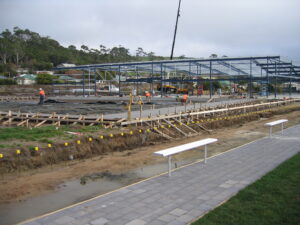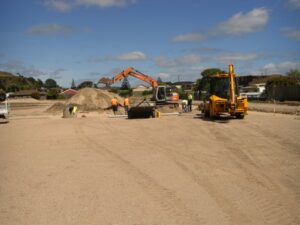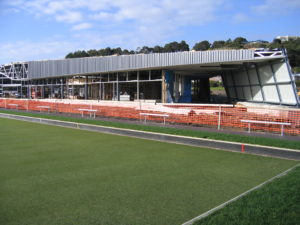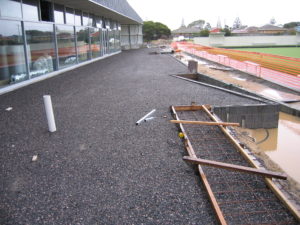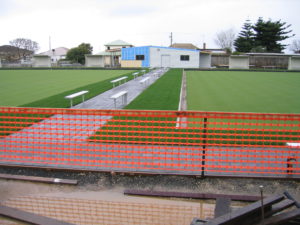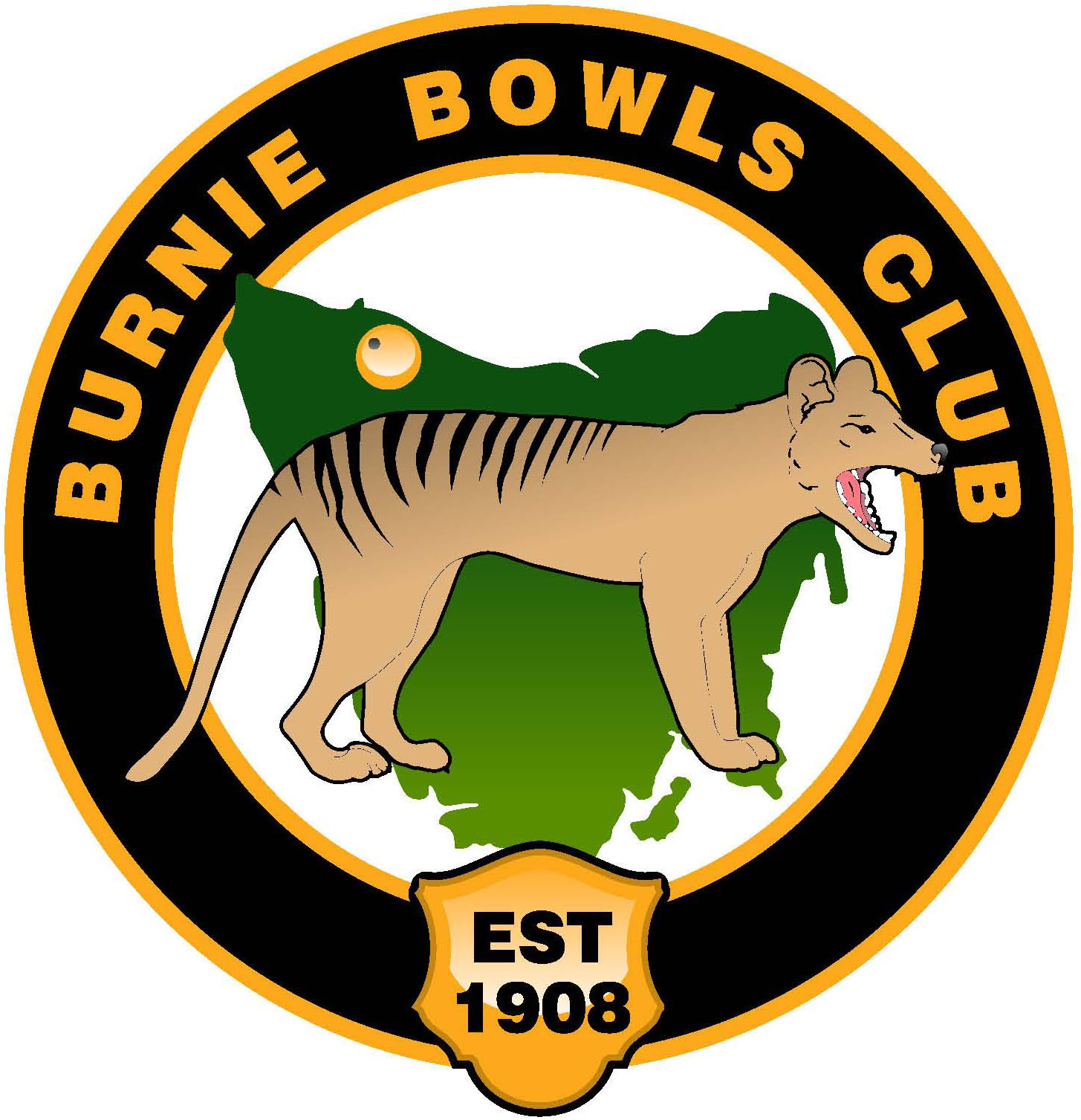Club History
Campsite to City by Kerry Pink
Lawn Bowls (from A Sporting Town pp315..318)
The centuries-old game of lawn bowls became – part of the Burnie sports scene in 1908 when the first green was laid on the newly-developed sporting reserve on the West Park foreshore alongside the football, cricket and athletics oval. The Burnie Bowls Club was formed at a meeting convened by the Burnie Tourist Association in the old Town Hall on 8 March 1907 which elected TJ Crisp as president, Thomas Wiseman Jr as vice-chairman, PJ Cherry secretary and Jabez Tong treasurer.
Others at the meeting elected to the committee included FJ Tallack, JL Roscoe, HB Kilburn, CJ Harris, WE Hodgman, AD Raymond and EA Pearson.
Some members of the Town Board initially opposed a portion of the new sports reserve area, then being leased from the Anglican Church, being granted to the Bowling Club, claiming there would be only a limited participation in the sport. However, agreement was eventually reached – probably with the support of local builder Frank Tallack, a foundation committee member who also happened to be chairman of the Town Board at the time.
The area chosen just east of the West Park Oval was a stony piece of land growing only tussocks, separated from the rocky foreshore only by the railway line. Local contractor Joseph Nothrop carted rubble from Round Hill and sand from Wivenhoe as a base for the first greens and J Barker provided and spread the surface topsoil, which was improved in later years following a Launceston green keeper’s advice to top dress the rinks with Mowbray Swamp loam. Two players who were to become stalwarts of the club, Harry Mollison and Jabez Tong, gave their time voluntarily to prepare the rinks for play.
The Burnie Bowling Club’s first green was officially opened on 9 November 1908. King Edward VII’s birthday holiday, when Grace Crisp, wife of the club president, sent down the first kitty. Secretary Phil Cherry was the club’s first champion.
The cost of the bowling green and 15ft by 10ft clubhouse was £450 and the work was financed from the sale of £2 10s debentures to members and other interested citizens at 5% interest. Sixty-six were sold and some were still being repaid in the late 1920s. The initial membership fee of £1 1s was doubled within two years and even then the club had financial difficulties which required regular fundraising activities ranging from euchre tournaments to street stalls.
From the outset the Burnie Bowls Club affiliated with the Northern Tasmanian Bowling Association and the club won its first intra-state match against Ulverstone in 1909. Matches against Devonport and Ulverstone began a year later and in 1927 the NWTBA was formed with Burnie, Devonport, Latrobe, Ulverstone, Penguin and Wynyard contesting the pennant.
A women’s croquet lawn was laid adjoining the bowling greens in 1911 and by 1934 the desirability of admitting ladies as associate members was being discussed by the all-male Burnie Bowling Club. The suggestion did not have unanimous support. In its report of the club’s annual meeting in 1934 The Advocate reported:
Members were divided on the matter, some stating that the presence of lady bowlers on the green would add greatly to the attraction of the game, while others were of the opinion that the lady bowlers would ruin the club and spoil the game for men.
Club president Frank Abell and secretary Edgar Trethewey supported the idea, but others were not so sure. Local chemist W.H. Brookman suggested that the matter be deferred and dealt with at a later date. It was not, in fact, until 1948 that women bowlers were admitted as associate members and the croquet lawns handed over for bowls.
The original little clubhouse pavilion was extended and eventually replaced by a new pavilion in 1958, the club’s 50th jubilee year and this also was later modernised and extended and named after club stalwart and president from 1946-69, Gordon Stokes, father of footballs Ray and Jervis. Gordon was also president of the NWTBA and TBA. In line with other bowls clubs, Burnie decided in 2000 to name its greens after prominent members. The first to be honoured was Rex Collins, club champion four times in the 1970s and 1983 and a former club president. The Burnie Bowls Club now has twenty rinks and more than 150 men and women members.
The Burnie Bowls Club has produced some champion bowlers since its inceptions and few, if any held a better record than Edgar Trethewey, one of Burnie’s top all-round sportsmen earlier last century. Edgar Trethewey moved from the East Coast to Burnie in 1901 to take a job as an office boy with the Emu Bay Railway Co, eventually rising to paymaster. He soon make a name for himself in local sport, joining the Wanderers football team in 1905 and play A grade cricket. He won the Burnie Gift on the old South Burnie ground in 908 and dead-heated in the final two years later. He began playing bowls in 1914 after a football injury and between 1917 and 1958 won the Burnie Bowls Club singles title fifteen times, the NWTBA singles title six times and the Tasmanian singles championship in 1934.
Leigh Bishop, ex-APPM and Burnie Tigers footballer won the Burnie Bowls Club singles title nine times between 1955 and 1968 and the State title in 1963 before joining the Wynyard Bowls Club in 1972.
“I left the Burnie Club because my thirteen-year old son, Craig, wanted to take up the sport, but the Burnie committee wouldn’t alter the rules to allow membership under the age of 21”, said Leigh. “My wife had to take Craig to the Port Sorell club to play. However, the Wynyard club agreed to allow teenagers to join so we transferred. Brian Harrison and his son Mark did the same and this became the first move for under-age bowls in the NWTBA.”
Leigh Bishop won the Wynyard club’s singles title in 1972 and 1973, giving him 13 club singles championships in 15 years. In 1975 he joined South Burnie and was chosen to represent Australia in the third World Bowls Championships in South Africa in 1976 when the Australian fours won silver – beaten for gold only on percentage. In addition to his record as a player, Leigh Bishop became a top administrator in Tasmania and nationally.
The club experienced a lean period in the NWTBA during the period to 1990s when resurgence occurred. This was due mainly to several ‘imports’, and the work done by Ken Willie in attracting them: Leigh Bishop and Michael Hill from South Burnie, and Bruce Frith and Colin Ramsden from Wynyard. During the 1990s to 2005, Division 1 won 12 of 16 NWTBA titles and Division 2 won nine during the same period, including seven state titles between them.
In 2008 the club celebrated its centenary at the original site and unveiled the Burnie Bowls Club Team of the Century.
Ed: The following season (2009-10), the club moved to its new location at Les Clark Oval in Cooee. Since the move, the club has continued to enjoy success on the green while building a new club culture.



